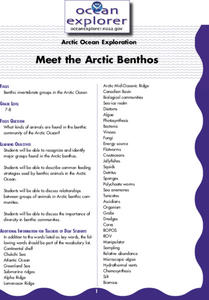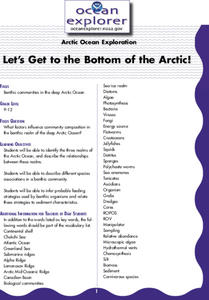Curated OER
Patterns Across Cultures: The Fibonacci Sequence in Visual Art
Students study the origin of the Fibonacci Sequence. In this investigative instructional activity students identify works of art where Golden Spiral or Ratio appear.
Curated OER
You Too Can Haiku: How to Write a Haiku
Students explore language arts by writing their own poems. In this haiku lesson, students investigate the Japanese culture and their beautiful music, poetry and art. Students count the syllables in every line of a haiku poem and write...
Curated OER
Experimenting with Sound
Students explore physical science by completing a worksheet. In this sound perception lesson, students collaborate in small groups to research sound properties on the Internet and in libraries. Students conduct a listening experiment by...
Curated OER
Spelling List 11: Sight Words, Short "e,-ea-" Pattern, and Academic Vocabulary
In this spelling worksheet, students practice their spelling words that include sight words, short e/ea pattern, and vocabulary. Students practice spelling 16 words.
Curated OER
Understanding to Read and Describe It
Second graders, with hearing disability, practice vocabulary building strategies. In this vocabulary strategy lesson, a student practices sight words using word cards. The student verbalizes a sentence with the new words while the...
Curated OER
Learning to Summarize a Story
Students with hearing loss read independently and understand what is being read to them. In this independent reading lesson plan, students sequence and discuss the book that is read.
Curated OER
Ocean Exploration
Students explore a simulated ocean floor. In this environmental lesson plan, students take on roles of an ocean dive team exploring the ocean floor. Dive logs will be created and the students will explore their sections of simulated...
Curated OER
Ayumi Hamasaki
In this famous people worksheet, students read a passage about Ayumi Hamasaki and then complete a variety of in-class and homework activities to support comprehension, including partner interviews, spelling, cloze, synonym matches, and...
Curated OER
The Invention of the Telephone
Students study the history of the telephone and its inventor. In this communications lesson plan students complete a tuning fork experiment to further demonstrate how sound is produced.
Curated OER
Light at the Bottom of the Deep, Dark Ocean?
Students participate in an inquiry activity. They relate the structure of an appendage to its function. They describe how a deepwater organism to its environment without bright light.
Curated OER
Sayings Quiz: Will
In this online quiz instructional activity, middle schoolers read the sentences containing the English sayings and select the correct answer to complete the 10 exercises.
Curated OER
Mapping Seamounts in the Gulf of Alaska
Students describe major topographic features on the Patton Seamount, and interpret two-dimensional topographic data. They create three-dimensional models of landforms from two-dimensional topographic data.
Curated OER
Arlo's War by Frank Brennan
In this reading selection worksheet, students read a 9 page selection entitled, "Arlo's War," by Frank Brennan. There are no directions given with the reading selection.
Curated OER
Sign Language Tag
Students work on their sign language skills using yarn balls to tag with and cones for boundaries.
Curated OER
The Heart
Students are introduced to the parts of the heart and the flow of blood through the heart.
Curated OER
Hawaiian Bowl!
Students describe the movement of tectonic plates in the Hawaiian archipelago region. They describe how a combination of hotspot activity and tectonic plate movement could produce the arrangement of seamounts obse
Curated OER
Lights in the Deep
Students describe, compare, and contrast bioluminescence, fluorescence, phosphorescence, and chemiluminescence. They explain the role of three major components of bioluminescent systems. They ex
Curated OER
Seals, Corals and Dollars
Students described the ecological relationships between Hawaiian monk seals and deep-water precious corals. They describe and explain at least two different viewpoints on how monk seals and precious coral resources
Curated OER
Currents: Bad for Divers; Good for Corals
High schoolers describe, compare, and contrast major forces that drive ocean currents. They discuss the general effects of topography on current velocity. They discuss how velocity affects the ability
Curated OER
Hudson Canyon Expedition Let's Bet on Sediments!
Students investigate and analyze the patterns of sedimentation in the Hudson Canyon students observe how heavier particles sink faster than finer particles. They study that submarine landslides (trench slope failure) are
Curated OER
Meet the Arctic Benthos
Students recognize and identify major groups found in the Arctic benthos. They describe common feeding strategies used by benthic animals in the Arctic Ocean. They discuss relationships between
Curated OER
Let's Get to the Bottom of the Arctic!
Students identify the three realms of the Arctic Ocean, and describe the relationships between these realms. They describe different species associations in a benthic community.
Curated OER
All That Glitters...
Learners study that white light (visible light) is comprised of all colors of the spectrum. They study that the quantity of light decreases with increasing depth in the ocean. They study that the quality of light changes with increasing...
Curated OER
Spawn!
Pupils explain that the ability of certain reef fishes to have a successful spawning is dependent on numerous environmental conditions. They list some of the factors needed by reef fishes in the South Atlantic Bight to have a
Other popular searches
- Deaf Community
- Hearing Impaired Deaf
- Deaf English Language Arts
- Deaf Leaders
- Deaf Culture
- Deaf Students
- Deafness and Blindness
- Generational Studies Deaf
- Deaf America
- Deaf Education Program
- Deaf Blind
- History of Deaf Community

























